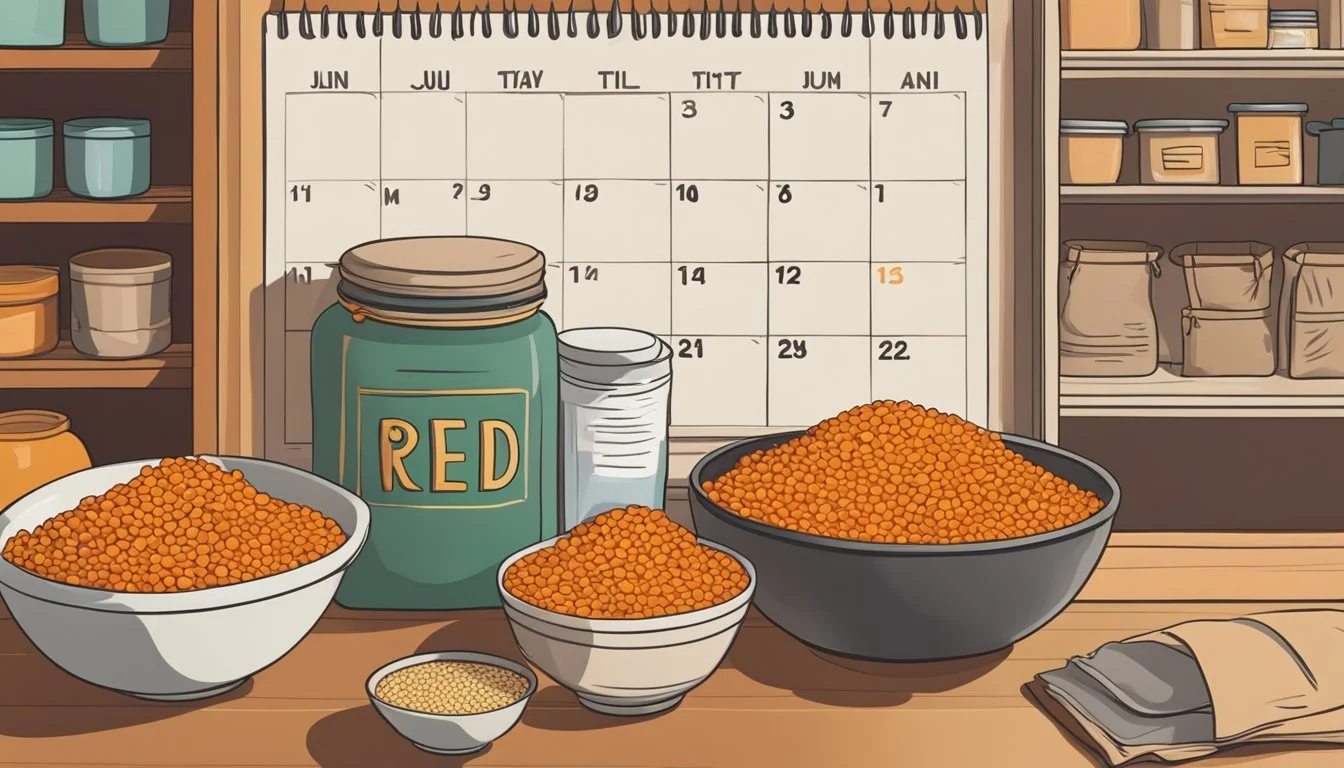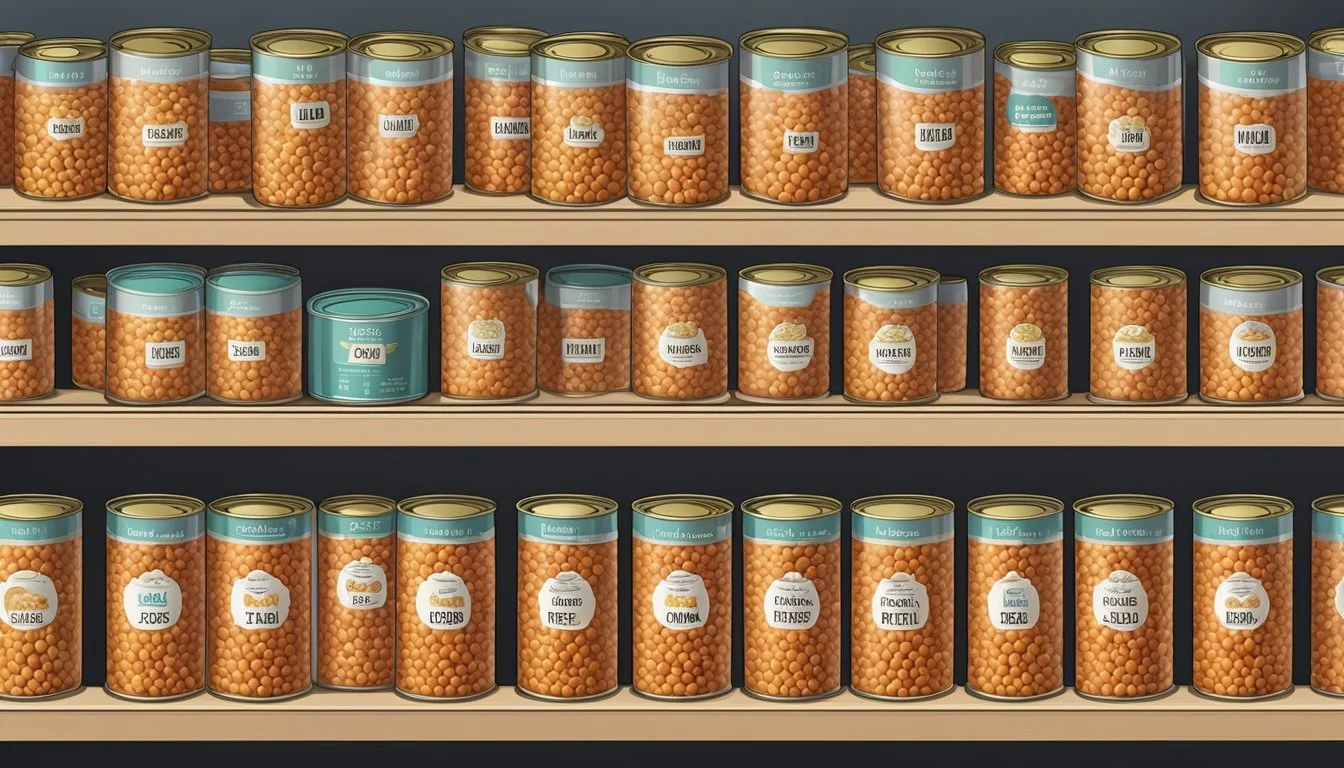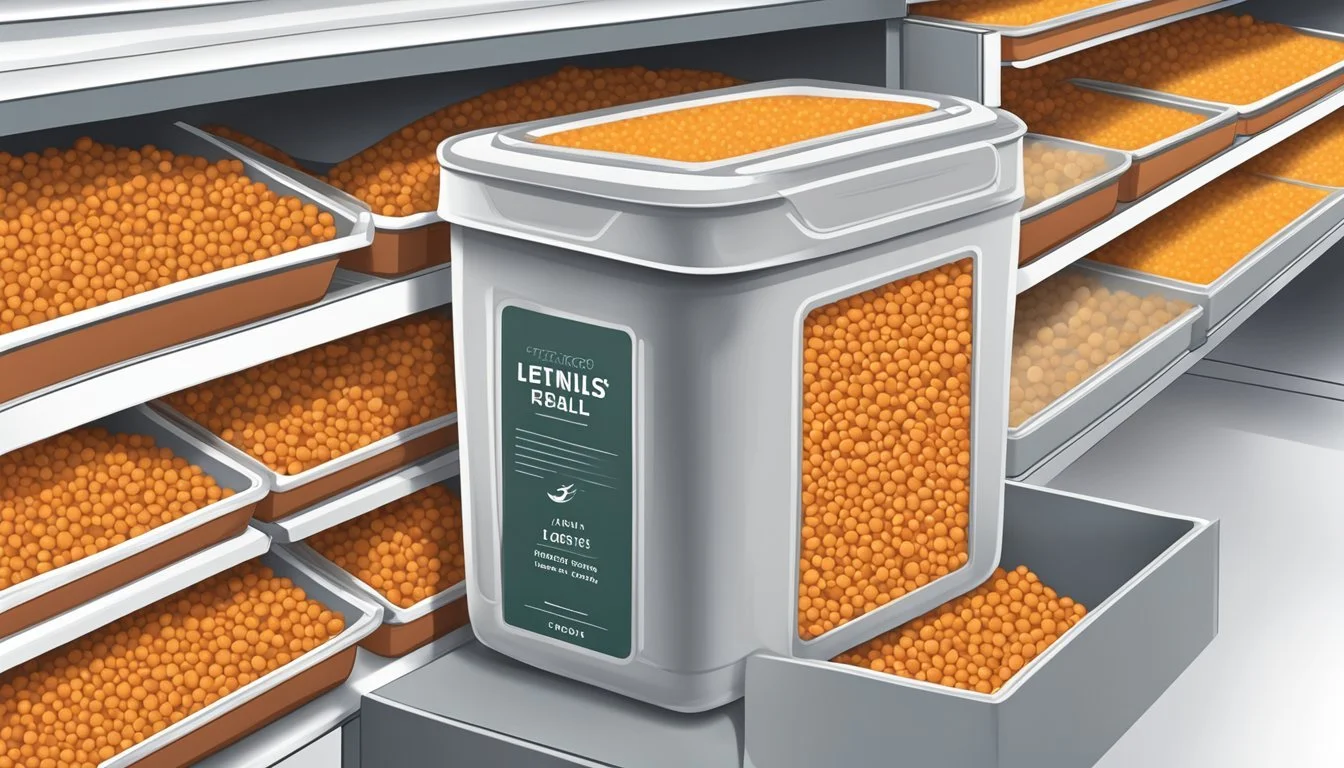How Long Do Red Lentils Last?
Shelf Life and Storage Tips
Red lentils are a staple in many kitchens, valued for their quick cooking time and nutritional benefits. Understanding the shelf life of red lentils is crucial for maintaining their quality and ensuring food safety. Generally, when stored properly in a cool, dry place, red lentils can last for up to two to three years. This longevity makes them an excellent dry good to keep on hand for both daily use and long-term food storage.
The packaging and storage conditions play a vital role in the preservation of red lentils. To maximize their shelf life, they should be kept in an airtight container away from moisture, heat, or sunlight. If these conditions are met, consumers can expect the lentils to retain their quality within the given timeframe. Once cooked, red lentils should be consumed within 3-5 days when stored in the refrigerator, and they can also be frozen for extended use.
Understanding Lentils
Lentils are a staple in many diets around the world, prized for their nutritional value and versatility in various dishes. They come in multiple varieties, each with a unique color, texture, and taste, but all sharing a rich profile of essential nutrients.
Lentil Varieties
Lentils exist in several types, each distinctively contributing to global cuisines. The most common types include:
Red lentils: These cook quickly and typically become soft and mushy, making them ideal for soups and purees.
Brown lentils: A versatile variety that retains its shape well, perfect for salads and stews.
Green lentils: Known for a slightly peppery flavor, they too maintain their firmness after cooking and are used similarly to brown lentils.
French lentils (Puy lentils): These have a firm texture and are often used in French and Mediterranean cooking.
Yellow lentils: Mostly found in Middle Eastern and Indian recipes, they are sweet and nutty in flavor.
Nutritional Profile
As a highly nutritious legume, lentils offer a significant amount of essential nutrients. For every one-cup serving, lentils provide:
Protein: About 18 grams, making them a powerful source for vegetarians and vegans.
Fiber: Approximately 15 grams, contributing to digestive health and satiety.
Iron: Vital for blood health, lentils are an excellent source.
Folate: Important for DNA synthesis and repair.
Potassium, zinc, and various vitamins: Essential for overall bodily functions.
Lentils are a powerhouse of nutrients, with each variety containing these essential minerals and vitamins, though in varying amounts.
Legumes in Cuisine
Their versatility sees lentils being central to dishes across various cuisines. They can be found in everything from hearty soups and spicy dahls to refreshing cold salads and savory pâtés. Lentils are also favored because they can absorb flavors from other ingredients, enhancing the dish's taste profile. Each variety, be it red, green, or French lentils, offers a different texture and flavor that can be tailored to a recipe's specific needs, making them a beloved ingredient among cooks and chefs worldwide.
Shelf Life of Uncooked Lentils
Uncooked red lentils, known for their quick cooking time, are a nutritious pantry staple with a commendable shelf life if stored properly. This section explores the various factors affecting that longevity, ideal storage conditions, and how to discern deterioration.
Dry Lentils Storage
To maximize shelf life, dry lentils should be kept in a cool and dry place. Placing them in airtight containers or sealed plastic bags is ideal. This prevents exposure to moisture and air, which can compromise quality and lead to spoilage.
Factors Impacting Shelf Life
Proper storage plays a pivotal role in prolonging the life of dry lentils. Storage conditions like temperature, exposure to light, and humidity levels significantly impact shelf life. Lentils should be stored away from direct sunlight and sources of heat to prevent degradation.
Identifying Spoilage
While dry lentils have a long shelf life, they can go bad. Signs of spoilage include a noticeable change in color, a musty smell, or the presence of mold or insects. Any visible mold, moisture, or pest infestation is a clear indication that lentils are no longer suitable for consumption.
Food Safety
Expiration date is not an absolute indicator of spoilage, but a guideline. Bacterial growth can lead to food poisoning, so discarding any lentils that show signs of spoilage is crucial. Always inspect the package before use and wash lentils thoroughly to ensure food safety.
Storing Cooked Lentils
Properly storing cooked lentils is crucial for maintaining their quality and preventing food poisoning. The following practices ensure the best outcomes for refrigerating and freezing lentils, as well as safety tips for reheating.
Refrigeration Best Practices
To maximize the shelf life of cooked lentils in the fridge, they should be stored in an airtight container or a sealed bag. Lentils should be placed in the refrigerator within two hours of cooking to prevent bacterial growth. Typically, cooked lentils last for 3-5 days in the refrigerator.
Timeframe: 3-5 days
Temperature: Keep at or below 40°F (4°C)
Containers: Use airtight or sealed containers
Freezing Cooked Lentils
For longer-term storage, freezing cooked lentils is an effective method. When freezing, use an airtight container or a heavy-duty freezer bag to prevent freezer burn and flavor loss. Cooked lentils can maintain their best quality in the freezer for up to 6 months.
Timeframe: Up to 6 months
Container: Airtight or heavy-duty freezer bags
Defrosting: Thaw in the refrigerator or use the microwave's defrost setting
Reheating and Consumption Safety
When reheating leftovers, ensure that lentils reach an internal temperature of 165°F (74°C) to ensure safety from potential foodborne bacteria. Always inspect lentils for signs of spoilage, such as an off odor or appearance, before consuming.
Reheating Temperature: 165°F (74°C)
Safety Check: Inspect for signs of spoiling
Avoiding Gas: Reheat gently to reduce the likelihood of causing gas
Abiding by these storage and reheating measures helps mitigate risks of foodborne illness and optimizes the sensory qualities of cooked lentils during storage.
Canned Lentil Storage
When it comes to preserving the quality and safety of canned lentils, proper storage is paramount. The longevity of canned lentils is greatly influenced by storage conditions and can differ from the printed best-by date.
Unopened Cans
Canned lentils, if unopened, can last quite long due to the airtight environment that hinders bacterial growth. Typically, these lentils maintain quality until the best-by date and often beyond, as long as they're kept in a cool, dry place away from direct sunlight and heat sources. For optimal longevity, it's best to store the cans at room temperature, generally considered to be between 50°F and 70°F (10°C and 21°C).
After Opening
Once opened, canned lentils should be transferred to an airtight container if not used immediately. Refrigeration is necessary to slow down bacterial growth, and the lentils should be consumed within 3-5 days. To optimize shelf life post-opening, consider freezing the lentils; they can last up to 6 months in the freezer while maintaining their quality.
Visual and Olfactory Indicators
Lentils can potentially go bad, and signs of spoilage should be taken seriously for food safety. It's essential to inspect the tin for rusting, denting, or leaking before use, as these are precursors to potential contamination. Upon opening, if canned lentils exhibit an off-odor, mold, or an unusual texture, they should be discarded. Trusting one's senses is a key safety measure; when in doubt, do not consume expired canned lentils, as they may harbor bacteria that could lead to foodborne illness.
Maximizing Shelf Life
To maintain the quality and nutritional value of red lentils, which includes carbohydrates, fiber, and protein, proper storage conditions are essential. This section helps to ensure that your legumes stay fresh for as long as possible.
Ideal Conditions and Containers
Red lentils benefit most from storage in cool and dry places away from direct sunlight. This legume, a stable pulse in countries like India, should be kept in airtight containers to prevent exposure to moisture and other environmental factors that can lead to spoilage.
Airtight Containers: Utilize glass or plastic containers with tight-sealing lids.
Location: Store containers in a pantry or cupboard at temperatures below 25 degrees Celsius (77 degrees Fahrenheit).
Combating Common Storage Issues
Dry and dried lentils, especially when bought in bulk, can be susceptible to common storage issues such as moisture build-up and pest infestation.
Moisture: Silica gel packets can reduce humidity levels in storage containers.
Pests: Regularly inspect lentil containers for signs of insects or rodents.
To prevent signs of spoilage and retain the storage quality of red lentils, follow these guidelines for handling and storing the beans. When stored properly, red lentils, like many pulses, can have an extended shelf life, allowing you to enjoy their nutritional benefits for many meals to come.
Preparing Lentils for Cooking
Before cooking red lentils, it is essential to prepare them correctly to ensure they cook evenly and provide their full nutritional value, including high fiber, protein and a wealth of minerals like iron.
Sorting and Rinsing
Sorting: Prior to rinsing, one should spread the red lentils out on a light-colored surface and sort through them to remove any small stones, debris, or shriveled lentils that may have been mixed in during packaging.
Rinsing: After sorting, red lentils should be thoroughly rinsed under cold water in a fine mesh strainer. This step not only cleans the lentils but also removes any dust or residues that could cloud cooking liquids or affect the taste of the finished dish.
Cooking Time Considerations
Cooking Times: Red lentils have one of the shortest cooking times among legumes:
Whole red lentils: 30 to 45 minutes
Split red lentils: 8 to 15 minutes
For Lentil Soup or Curry: If preparing a soup or curry, one should consider that red lentils will thicken the broth as they cook. Therefore, more liquid may be required than when cooking lentils alone.
Combining with Grains: When cooking red lentils with rice or quinoa, (What wine goes well with quinoa?) it's important to synchronize cooking times. Typically, red lentils can be cooked together with these grains as they have similar cooking durations.
Note: Cooking time can be affected by factors such as lentil age and water hardness. Adjust the time as needed and taste test for doneness.
The prepared lentils should be cooked until they are soft but still hold their shape to avoid a mushy texture, unless one desires a creamier consistency for dishes like lentil soup.
Culinary Application and Recipes
Red lentils are a versatile ingredient in the kitchen, known for their quick cooking time and high nutritional value. They offer a wealth of protein, fiber, vitamins, and minerals, making them a staple in both traditional and modern recipes.
Traditional Dishes
One can often find red lentils in traditional dishes such as lentil soup and lentil curry. These meals are not only rich in flavor but are also infused with nutrients, supporting a balanced diet. Lentil soup typically combines lentils with vegetables and spices, simmering until the legumes are tender. In lentil curry, the pulses are cooked with a blend of aromatic spices and herbs, often featuring a mix of turmeric, cumin, and coriander.
Lentil Soup Example:
Cook Time: Approx. 30 minutes
Key Ingredients: Red lentils, onions, carrots, celery, garlic, broth, and spices.
Lentil Curry Example:
Cook Time: 15-20 minutes for split red lentils
Core Spices: Turmeric, cumin, coriander, garam masala.
Modern Fusions
Chefs are experimenting with red lentils to create modern fusions that cater to a contemporary palate. They are blended into quinoa salads for added protein or used as a base for innovative veggie burgers. Their adaptability allows them to fit into various dietary preferences, pairing well with a multitude of flavors and ingredients.
Combo: Red lentils, quinoa, diced vegetables, lemon vinaigrette.
Nutritional Boost: Complete protein from the mix of lentils and quinoa.
Accompaniments and Pairings
Red lentils complement a variety of side dishes, particularly grains such as rice. Their mild, slightly sweet flavor profile can enhance the overall meal without overpowering other components. In addition, their texture makes them an exquisite addition to salads and stuffings, offering a heartier and nutritionally dense experience.
Pairings with Rice:
Simple Pairing: Basmati rice served with red lentil curry.
Nutrient Fact: Combination provides a complete amino acid profile.
By incorporating red lentils into different culinary contexts, they not only bring a burst of flavor and nutrition but also a satisfying experience tailored to various tastes and traditions.
Buying and Storage FAQ
When purchasing red lentils, prospective buyers should consider shelf life and proper storage to maintain quality. This section addresses frequently asked questions and provides expert tips to maximize longevity.
Common Questions
How long do red lentils last?
Uncooked red lentils have a shelf life of 1-2 years when stored under optimal conditions, which include a cool, dry place away from direct sunlight. They should be kept in an airtight container to prevent moisture and pests.
Can you freeze red lentils?
Yes, one can freeze red lentils, either cooked or uncooked, to extend their shelf life. For uncooked lentils, place them in an airtight container or freezer bag. Cooked lentils can be frozen for up to 6 months, provided they are stored properly in a sealed container.
Do red lentils ever go bad in the fridge?
Cooked red lentils will typically last in the refrigerator for 3 to 4 days. If the smell, texture, or color is off, they should be discarded.
Is it advisable to buy red lentils in bulk?
Buying in bulk can be economical, but one must consider storage capacity and usage rate. Storing large quantities improperly could lead to spoilage before they're used.
Expert Tips for Longevity
Proper Storage for Uncooked Red Lentils:
Store in a cool, dry location away from heat sources.
Use an airtight container or a vacuum-sealed bag to prevent moisture ingress and insect infestation.
Maintaining Quality:
Regularly check bulk supplies for signs of moisture or pests.
Split lentils might have a reduced shelf life compared to whole ones due to exposed surfaces.
Freezing Guidelines:
To freeze cooked lentils, ensure they are cooled before transferring to an airtight container.
Label frozen lentils with dates to keep track of how long they have been stored.










